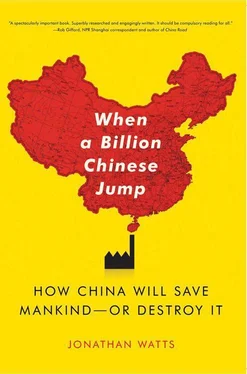Suddenly, I felt thrilled to be alive, relishing every second of the experience. Feeling such elemental extremes was terrifying but also a privilege. It lasted a few hours. The tent leaked a little. There was another, smaller aftershock. Then the storm eased, the earth settled, and I drifted off to sleep.
There was no sign of Wang the next morning. I presumed he had slipped away before the soldiers woke. He faced a perilous journey. People were still being crushed by landslides and tumbling boulders. I felt guilty and worried, but also relieved that I wasn’t with him. Not for the first time as a journalist I wished a person well as I left them to dangers I was unwilling to face. To this day, I wonder what became of Wang. 49
The cause of the Sichuan quake remains contentious. While it is still classified as a natural disaster, some scientists believe the Zipingpu Dam may have been at least partly responsible.
Geologists noted the Yingxiu-Beichuan fault line had been relatively inactive for thousands of years before the dam was built. Fan Xiao, a chief engineer of the Sichuan Geology and Mineral Bureau, argued that the 320 million tons of water in the reservoir may have jigged it back into life. 50His views won support from several foreign seismologists.
“The added weight [of the Zipingpu reservoir] both eased the squeeze on the fault, weakening it, and increased the stress tending to rupture the fault,” wrote geophysical hazards researcher Christian Klose of Columbia University’s Lamont-Doherty Earth Observatory. “The effect was 25 times that of a year’s worth of natural stress loading from tectonic motions … When the fault did finally rupture, it moved just the way the reservoir loading had encouraged it to.” 51
Reservoir-induced seismicity is a known phenomenon. There have been several well-documented cases across the globe. 52In the planning stage for the dam on the Min, Fan and other scientists had warned of the risk of a quake but they were ignored. 53
The government rejected claims that Zipingpu caused the quake. Several senior Chinese geologists said seismic activity was unchanged after the reservoir filled and that, in any case, the 280-kilometer rupture in 2008 was far too great to have been caused by a dam. While evidence for a link is inconclusive, their views have prevailed. The power of the hydroengineering lobby is unshaken. A year after the disaster, the authorities announced plans for twenty new plants on the upper Yangtze and its tributaries, many of them close to fault lines. 54These were not the only risks that development posed to Asia’s greatest river, nor were humans the worst affected victims.
4. Fishing with Explosives
Hubei and Guangxi
Although the cranes have wild instincts and are free to leave the royal park, the king’s moral government makes them stay, their captivity… being their reason for joy.
—Early Han dynasty poet 1
I had never heard of the baiji before coming to China. Even then, I did not pay much attention at first. As far as I could tell, the Yangtze dolphin was just another item on the endangered species list. Little news there. So many creatures were at risk that I had grown almost numb to reports about the loss of the wild. But then I was assigned to cover an international search for the animal. No story has made more powerful impression on me.
It began with a shipful of high hopes and good intentions. The launch party in Hubei on the misty banks of the Yangtze gathered together the great and the good of the marine biology community. 2On the deck of the Kekao 1 survey ship, I clinked glasses with the world’s leading zoologists and sonar engineers. Local communist cadres chatted with executives from the American beer company that was cosponsoring the project. The Swiss philanthropist who helped to organize the mission was ebullient that, after years of preparation, something was finally being done. Alcohol foamed down a cascade of champagne glasses as the dignitaries posed for the cameras. The speeches mentioned unprecedented international cooperation, state-of-the-art equipment, and determination not to give up on the baiji. The dolphin was in danger, but if anyone could find and save the animal, it was this group. I couldn’t help thinking this would make a great start for a feel-good Hollywood movie. Indeed, we seemed to be on the set of a film. Our ship, decked out in bright bunting, red-bannered slogans, and a display of corporate donor logos, was an incongruous sight amid the empty gray farm fields and swirling brown waters of the river. To any passing farmer we must have made a peculiar spectacle.
At least something was being done. The expedition was a last-gasp effort to save a remarkable creature. 3August Pfluger, the enthusiastic Swiss millionaire who helped to pull the team together, and Samuel Turvey of the Zoological Society of London explained the animal’s significance and its decline as we embarked on our journey.
Between twenty and twenty-five million years ago, a pale, long-snouted dolphin left the Pacific Ocean and began navigating the muddy brown waters of the Yangtze. Over time, it became distinct from other cetaceans. Eyesight was of little use in the murky river and it became almost blind, developing instead a highly sophisticated sonar for navigation. With fish plentiful and predators few, the baiji flourished. Until a few thousand years ago they would have been a common sight, frolicking by sandbars as tapirs emerged from densely forested riverbanks to drink waters that sustained as rich a variety of life as the Amazon does today. In that golden age of ecological diversity elephants ranged from the Yangtze to Beijing, where they lived wild along with Bactrian camels and a cornucopia of other species in an area that was then densely forested.
Man was a latecomer. The earliest archaeological records of Homo erectus (upright man) date back about two million years to Africa. It was another million years before their descendants moved to Asia and probably several hundred thousand years more until they reached southern China. But certainly by 6500 bc our species—by then evolved to Homo sapiens (wise man)—had settled in the Yangtze delta and domesticated rice for the first time in human history. 4
Early civilizations worshipped the baiji as a river goddess. 5Capable of growing up to 2.5 meters in length, able to swim up to 60 kilometers per hour, and communicating in a series of clicks and whistles, the creature would have mystified our ancient ancestors. In one ancient romance, a baiji is transformed into a beautiful maiden who falls in love with a man. 6In other writings, the dolphin is adored as the “Goddess of the Yangtze.”
Over the years, the baiji has been known by many names, but the most prescient was given by the first Westerner to record its existence: Lipotes vexillifer, which is Latin for “left-behind flag bearer.” 7This proved appropriate, as the mammal, which preceded man in making a home in Asia by tens of millions of years, has effectively been abandoned for at least half a century. As humanity pressed into the Yangtze delta in ever-larger numbers, the dolphin was first neglected and then squeezed out of its habitat.
The Yangtze delta supports more than one in twenty of humanity and 40 percent of China’s economy. There is barely any room left for other species or activities. Elephants and tapirs have long since been driven away. Other fantastic creatures such as the Yangtze crocodile are now on the brink of extinction. The baiji may already be over the edge. Far more so than the giant panda, its demise illustrates the sacrifices that nature has been forced to make to support and enrich the world’s most populous country.
In the 1950s, there were 6,000 baiji in the Yangtze, their only home. From then on their numbers fell calamitously. By 1984, there were only 400 left, and since then their decline has followed an almost perfect inverse relationship to the nation’s economic rise. 8The last confirmed sighting was in 2002.
Читать дальше










